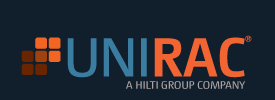 Unirac — a company that makes racks that are used to install and hold solar panels in place within power generating systems of any size — today revealed a new partnership with solar tech manufacturers, Canadian Solar Inc. (nasdaq: CSIQ).
Unirac — a company that makes racks that are used to install and hold solar panels in place within power generating systems of any size — today revealed a new partnership with solar tech manufacturers, Canadian Solar Inc. (nasdaq: CSIQ).
Through the partnership, the companies will install 30 MW of solar projects in Canada, starting with a 10.9 MW solar park in Napanee, Ontario. According to a Unirac press statement, Canadian Solar will serve as the engineering, procurement and construction entity on these projects, and Unirac will provide the racking infrastructure.
In May 2010, Albuquerque, N.M.-based Unirac sold to Hilti Group, a massive construction sector business. Before it became a wholly owned subsidiary of Hilti, Unirac’s sales increased 100% from 2009 to 2010 said the chief executive of Unirac, Doug May.
He sees tremendous growth ahead for U.S. based solar companies, especially those serving domestic power companies with made-in-America products, yet have capacity to export:
“The U.S. [solar market] was around 800 megawatts this year, and could grow to 2.5 gigawatts. We’re slated for growth, near-term. The utility market alone next year, could be the same size as the entire U.S. market was this past year,” May said.
Today, 90 percent of Unirac’s supply chain is in the U.S. — most of its aluminum, for example, is extruded in California — but it gets 10 percent of its supplies from Canada, Europe and Asia.
Since 2009, the company also began building manufacturing, assembly and shipping operations outside of New Mexico, to be closer to customers and take advantage of government incentives in other states and countries, when possible.
Unirac specifically established manufacturing operations in Canada, anticipating a boom in solar project building thanks to the country’s feed-in-tariffs and other incentives.
Subsidized or not, May believes that Unirac’s products can solve problems for those who hesitated to build solar power generating systems due to labor costs, before. He explained:
“Solar projects for large utilities take a long time to get approved, with so many transmission and environmental challenges to be dealt with. They are all massive construction projects.
When it comes to the cost of solar power, people always want to talk about module efficiency. That is important. But the racking has to last for twenty years, too.
If you have workers who have to put a bolt in, or who have to go back down to the ground over and over again to build these projects, it’s going to drive up the costs of solar overall. We think about that.
We put a huge amount of testing into understanding code, snow loads, wind loads, what the ground is doing, and all the factors that influence the racking and ultimately the solar [power generating] systems. Even though we’re not making the panels, it’s highly technical.
Ultimately, it’s about taking the cost out of solar projects at any scale and making renewable energy competitive.”
Unirac was backed by the Maryland-based, private equity group Global Environment Fund prior to its acquisition by Hilti. Competing manufacturers of racking equipment for the solar industry include Zep Solar, also a partner of Canadian Solar, and Sollega, which offers one rack made of recycled materials.